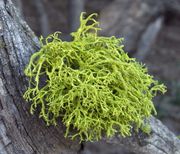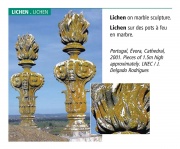Lichen
Description
Any of about 18,000 thallophytic organisms composed of an algae and a fungus growing in a symbiotic relationship on a solid substrate, such as a rock. Lichen have been used since ancient times as a source of food, medicine and dyes. Lichens grow relatively slowly (about 0.1 - 10 mm per year). Algae perform phtosynthesis producing carbohydrates and vitamins while the fungi absorb water vapour and provide a protective environment for the delicate algae. Their composite body is called a thallus and is classified as:
- squamulose: small, flat scales that do not adhere tightly to substrate
- crustose: flat, firmly attached to substrate
- foliose: leaf-like lobes, attached in the center to substrate by clusters of hyphae (rhizones); may reach several feet in diameter
- fructicose: plant-like growth attached at one point or cluseter called a holdfast
Additionally, Natural dyes have been extracted from lichens for several hundred years. Lichen dyes produces red, blue, yellow, purple and brown colors on wool. Many of these dyes are strong-acid base indicators, such as litmus.
Resources and Citations
- Wikipedia: Lichen at https://en.wikipedia.org/wiki/Lichen (June 2020)
- Encyclopedia Britannica, http://www.britannica.com Comment: "lichen" [Accessed April 26, 2002].
- G.Caneva, M.P.Nugari, O.Salvadori, Biology in the Conservation of Works of Art, ICCROM, Rome, 1991

